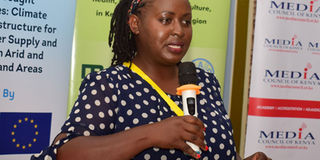Report: Eight counties account for 50pc of new HIV cases

Nascop Programme Officer Maureen Inimah addresses participants during the Kenya Science Journalists Congress in Mombasa between November 18, 2019. PHOTO | COURTESY
What you need to know:
Samburu had 20 new cases while Elgeyo Marakwet, Kirinyaga and Nyandarua counties had 31, 34 and 38 new HIV infections respectively.
Arid and semi-arid counties collectively contributed 25 per cent of all new HIV infections in children.
As Kenya prepares to mark the World Aids day on December 1, it is emerging that eight counties account for the 50 per cent of all new HIV infections.
Six of the counties that experts have raised a red flag over the increasing new infections are in Western and Nyanza. Other cases have been reported in Nairobi and Rift Valley.
All new HIV infections occur among adolescents and young people aged between 15-24 years.
The six counties include Homa Bay which leads with 700 new cases of infections followed by Siaya (620), Kisumu (616), Kakamega (437), Migori (432) and Busia with 318 new HIV infections.
NEW INFECTIONS
Nairobi County, which has the second highest rate of new infections, recorded at 660 new cases while Nakuru County tops in Rift Valley region with 325 new cases.
A recent report by National Aids and Sexually Transmitted Infections Control Programme (Nascop) revealed that at least 10 counties had the lowest cases of new infections.
The report was tabled during the recent Kenya Science Journalists Congress in Mombasa. The event was attended by more than 100 science journalists and experts from Kenya, Uganda, Tanzania, Rwanda and Malawi.
The congress held between November 18-20 was organised by the Media for Environment, Science, Health and Agriculture (Mesha).
The Nascop report tabled by Programme Officer Maureen Inimah further indicated that Wajir County had the lowest new infection rate with six cases.
Other counties with minimal cases were Tana River with 13, Lamu and Marsabit (16) while Mandera and Isiolo had 19 new cases.
FAMILY PLANNING
Samburu had 20 new cases while Elgeyo Marakwet, Kirinyaga and Nyandarua counties had 31, 34 and 38 new HIV infections respectively.
Arid and semi-arid counties collectively contributed 25 per cent of all new HIV infections in children.
The ASAL counties include Kilifi, which overall had 197 new infections, Machakos (185), Kitui (176), Kajiado (163), Turkana (152), Makueni (151), Meru (147), Narok (120), Kwale (115), Embu (66), Laikipia and Taita Taveta each had 61, Garissa (55), Tharaka Nithi (52), Nyeri (51), West Pokot and Baringo each had 39 new HIV infections.
The current mother to child transmission of HIV stands at 12.4 per cent. The government’s universal health coverage by 2022 and Vision 2030 aims at reducing HIV infections to 8.5 per cent.
The report revealed that last year, there was 428,807 uptake of family planning among adolescents and youth aged 15-24 years while 430,825 pregnant adolescent cases (10-19 years) were reported.
The report says at least one in every 10 adolescent girl and youth woman was pregnant while 77 facility maternal deaths among adolescents (10-19 years) were reported last year.
CONTRACEPTIVES
In a bid to address the problem Nascop has fast-tracked the procurement and distribution of HIV and STIs commodities that include medicines, contraceptives and nutrition products among others.
It is also providing capacity building and technical support for HIV response and coordinating resource mobilisation and partnerships, advocacy and demand creation for HIV services in all 47 counties.
To minimize the impact and further transmission of HIV and STIs, Nascop is empowering people and communities by coordinating services within and across sectors.
It is also creating enabling environment, strengthening governance and accountability and reorienting the model of care by advocating at national and county level for more allocation of resources to HIV/STI response.




